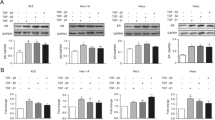Abstract
CCAAT/enhancer binding proteins (C/EBPs) are a group of transcription factors which have been implicated in cellular proliferation, terminal differentiation, and apoptosis in a variety of tissues including mammary gland. Owing to its role in various cellular functions, inactivation of C/EBP proteins is central to the pathogenesis of many disorders. Recent reports suggest that expression as well as function of C/EBP proteins is deregulated in breast tumors. Although, role of C/EBPs in growth arrest in mammary tissues has been studied in much detail; their role in apoptosis is relatively less explored. In the present study, we have assessed if breast tumors evade apoptosis and grow faster by down regulating and inhibiting the C/EBP proteins, C/EBPα in particular. Our data shows that ectopic expression of human C/EBPs in breast tumor cells inhibits proliferation and induces apoptosis which is likely to be associated with caspase dependent pathway.




Similar content being viewed by others
References
Gery S, Tanosaki S, Bose S, Bose N, Vadgama J, Koeffler HP (2005) Down-regulation and growth inhibitory role of C/EBPalpha in breast cancer. Clin Cancer Res 11:3184–3190
Zahnow CA (2002) CCAAT/enhancer binding proteins in normal mammary development and breast cancer. Breast Cancer Res 4:113–121
Bamberger AM, Makrigiannakis A, Schroder M, Bamberger CM, Relakis C, Gellersen B, Milde-Langosch K, Loning T (2004) Expression pattern of the CCAAT/enhancer-binding proteins C/EBP-alpha, C/EBP-beta and C/EBP-delta in the human placenta. Virchows Arch 444:149–152
Trivedi AK, Pal P, Behre G, Singh SM (2008) Multiple ways of C/EBPalpha inhibition in myeloid leukaemia. Eur J Cancer 44:1516–1523
Wang GL, Shi X, Salisbury E, Timchenko NA (2008) Regulation of apoptotic and growth inhibitory activities of C/EBPalpha in different cell lines. Exp Cell Res 314:1626–1639
Ramji DP, Foka P (2002) CCAAT/enhancer-binding proteins: structure, function and regulation. Biochem J 365:561–575
Sabatakos G, Davies GE, Grosse M, Cryer A, Ramji DP (1998) Expression of the genes encoding CCAAT-enhancer binding protein isoforms in the mouse mammary gland during lactation and involution. Biochem J 334(Pt 1):205–210
Robinson GW, Johnson PF, Hennighausen L, Sterneck E (1998) The C/EBPbeta transcription factor regulates epithelial cell proliferation and differentiation in the mammary gland. Genes Dev 12:1907–1916
Sivko GS, DeWille JW (2004) CCAAT/enhancer binding protein delta (c/EBPdelta) regulation and expression in human mammary epithelial cells: I. “Loss of function” alterations in the c/EBPdelta growth inhibitory pathway in breast cancer cell lines. J Cell Biochem 93:830–843
Timchenko NA, Harris TE, Wilde M, Bilyeu TA, Burgess-Beusse BL, Finegold MJ, Darlington GJ (1997) CCAAT/enhancer binding protein alpha regulates p21 protein and hepatocyte proliferation in newborn mice. Mol Cell Biol 17:7353–7361
Wang GL, Timchenko NA (2005) Dephosphorylated C/EBPalpha accelerates cell proliferation through sequestering retinoblastoma protein. Mol Cell Biol 25:1325–1338
Johansen LM, Iwama A, Lodie TA, Sasaki K, Felsher DW, Golub TR, Tenen DG (2001) c-Myc is a critical target for c/EBPalpha in granulopoiesis. Mol Cell Biol 21:3789–3806
Wang H, Iakova P, Wilde M, Welm A, Goode T, Roesler WJ, Timchenko NA (2001) C/EBPalpha arrests cell proliferation through direct inhibition of Cdk2 and Cdk4. Mol Cell 8:817–828
Wang X, Huang G, Mei S, Qian J, Ji J, Zhang J (2009) Over-expression of C/EBP-alpha induces apoptosis in cultured rat hepatic stellate cells depending on p53 and peroxisome proliferator-activated receptor-gamma. Biochem Biophys Res Commun 380:286–291
Dhawan P, Weider R, Christakos S (2009) CCAAT enhancer-binding protein alpha is a molecular target of 1,25-dihydroxyvitamin D3 in MCF-7 breast cancer cells. J Biol Chem 284:3086–3095
Cheng J, Yu DV, Zhou JH, Shapiro DJ (2007) Tamoxifen induction of CCAAT enhancer-binding protein alpha is required for tamoxifen-induced apoptosis. J Biol Chem 282:30535–30543
Muller C, Calkhoven CF, Sha X, Leutz A (2004) The CCAAT enhancer-binding protein alpha (C/EBPalpha) requires a SWI/SNF complex for proliferation arrest. J Biol Chem 279:7353–7358
Trivedi AK, Bararia D, Christopeit M, Peerzada AA, Singh SM, Kieser A, Hiddemann W, Behre HM, Behre G (2007) Proteomic identification of C/EBP-DBD multiprotein complex: JNK1 activates stem cell regulator C/EBPalpha by inhibiting its ubiquitination. Oncogene 26:1789–1801
Li N, Ragheb K, Lawler G, Sturgis J, Rajwa B, Melendez JA, Robinson JP (2003) Mitochondrial complex I inhibitor rotenone induces apoptosis through enhancing mitochondrial reactive oxygen species production. J Biol Chem 278:8516–8525
Wu FY, Chen H, Wang SE, ApRhys CM, Liao G, Fujimuro M, Farrell CJ, Huang J, Hayward SD, Hayward GS (2003) CCAAT/enhancer binding protein alpha interacts with ZTA and mediates ZTA-induced p21(CIP-1) accumulation and G(1) cell cycle arrest during the Epstein-Barr virus lytic cycle. J Virol 77:1481–1500
Umek RM, Friedman AD, McKnight SL (1991) CCAAT-enhancer binding protein: a component of a differentiation switch. Science 251:288–292
Hendricks-Taylor LR, Darlington GJ (1995) Inhibition of cell proliferation by C/EBP alpha occurs in many cell types, does not require the presence of p53 or Rb, and is not affected by large T-antigen. Nucleic Acids Res 23:4726–4733
Tenen DG (2003) Disruption of differentiation in human cancer: AML shows the way. Nat Rev Cancer 3:89–101
Welm AL, Timchenko NA, Ono Y, Sorimachi H, Radomska HS, Tenen DG, Lekstrom-Himes J, Darlington GJ (2002) C/EBPalpha is required for proteolytic cleavage of cyclin A by calpain 3 in myeloid precursor cells. J Biol Chem 277:33848–33856
Reddy VA, Iwama A, Iotzova G, Schulz M, Elsasser A, Vangala RK, Tenen DG, Hiddemann W, Behre G (2002) Granulocyte inducer C/EBPalpha inactivates the myeloid master regulator PU.1: possible role in lineage commitment decisions. Blood 100:483–490
Koschmieder S, Halmos B, Levantini E, Tenen DG (2009) Dysregulation of the C/EBPalpha differentiation pathway in human cancer. J Clin Oncol 27:619–628
Acknowledgments
We are very thankful to the council of scientific and industrial research (CSIR) and CDRI for their financial (IAP-0001) and generous support in the preparation of the manuscript. We also thank ICMR for providing research fellowship to Pooja Pal. The institutional (CDRI) communication number for this article is 7825.
Author information
Authors and Affiliations
Corresponding author
Rights and permissions
About this article
Cite this article
Pal, P., Lochab, S., Kanaujiya, J. et al. Ectopic expression of hC/EBPs in breast tumor cells induces apoptosis. Mol Cell Biochem 337, 111–118 (2010). https://doi.org/10.1007/s11010-009-0290-3
Received:
Accepted:
Published:
Issue Date:
DOI: https://doi.org/10.1007/s11010-009-0290-3




